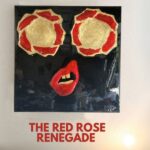By: Emma Thompson
Vyolet Jin’s solo exhibition “Night at the Museum of Inexplicable” was on display last month at Comiga Gallery in Williamsburg, Brooklyn, from April 12th to April 26th.
In this alternative display space turned into a hobbyist’s “closet to Narnia,” Vyolet brought to life her recreated solo project, “The Inexplicable Museum,” with a 3D realization of her digital paintings through the use of multiple mixed media. Just as a history museum is lined with
different decorative displays set side-by-side with large canvased images, Vyolet energized her uniquely whimsical ideas by putting to work anything from fluffy cumulus pieces to lego displays to the more traditional illustrator’s framed images.
Upon entering the space, the viewer’s attention is immediately drawn to the clouds hanging from the ceiling. These miniature clouds recreate a scene from one of The Museum’s iconic works: a duckling-shaped cloud hanging idly in the air, lost but seeking its “flock.” Crafted from cotton balls, the installation echoes the height of the space, imparting a sense of lightness and playfulness that sets the tone for the exhibition.
Approaching the works, an exhibition label is affixed to the underside of each work, describing each strange artifact. The concept behind the collection slowly unfolds—this is a marvelously mundane museum. Viewers ponder the juxtaposition of the ordinary and the challenge of recontextualizing these objects. Another curious display is that of a
sneaker-esque shoe that didn’t know itself as an object until it noticed its face in a mirror or a mysterious bouquet of star flowers lost in the void of space. Each piece has its own outlandish yet endearing preface that Vyolet can’t help but explain to you with a wide smile.
The Japanese concept of Modernology (Kōgengaku) was coined in the 1920s. The scholars who coined this term called themselves “road-observer.” One of the tenets of Modernology, beyond merely observing objects, is that the road-observers are always attuned to the stories behind them. In his book “Modernology,” Harahira Akasegawa wrote, “When we stand by the water’s edge, we can’t see any events because the surrounding environment is so calm; but when something intriguing like a bottle, doll, or fetus floats on the water’s surface, a strong aura of an event wafts out.” It is this sense of eventfulness that drove Vyolet to begin the series—not only observing the objects and being drawn to them but also strengthening their connection to art by creating secondary implications that detach themselves from the original objects and become Appreciable.
Color holds significant importance within Vyolet’s body of work, as it expresses deep emotions and brings her pieces to life with a sense of movement. In this series, Vyolet uses a limited color palette: green, yellow, and pink. They harmonize with other colors throughout the series, and it is easy to feel the artist’s philosophies of color theory and playfulness towards color as dynamic forces that are always pushing and pulling in their respective spaces.
“I consider myself a maximalist,” Vyolet says. She portrays highly generalized, symbolic characters carefully rendered with idiosyncratic detail. Her images are exquisitely composed and uncluttered. Holding both a BFA and MFA in Illustration from the School of Visual Arts, Vyolet Jin lives and works as an illustrator in New York and New Jersey. Her distinctive style has been featured in noted publications such as The New York Times. Notable accolades adorn her career, including honors from esteemed institutions like the Art Directors Club’s The Young Ones and the World Illustration Awards. This exhibition holds a deeply personal resonance for her—serving as a dedicated space for her cherished “enigmatic phenomena” to find solace and belonging.
Published by: Martin De Juan


















